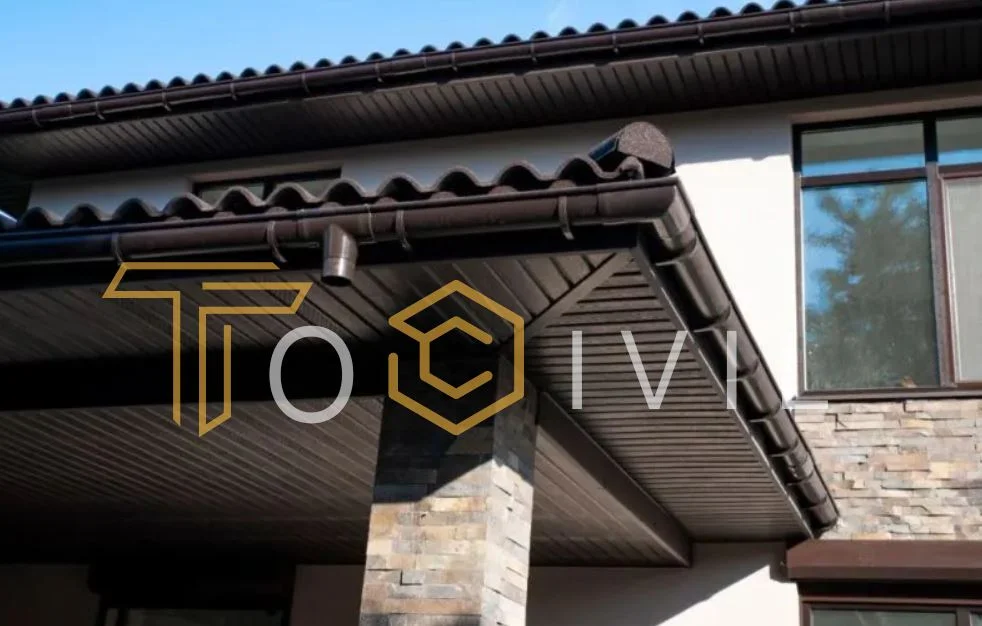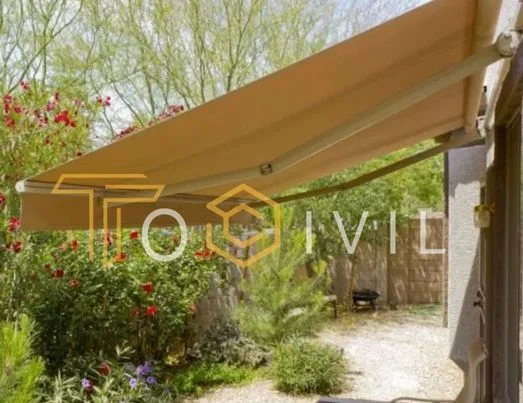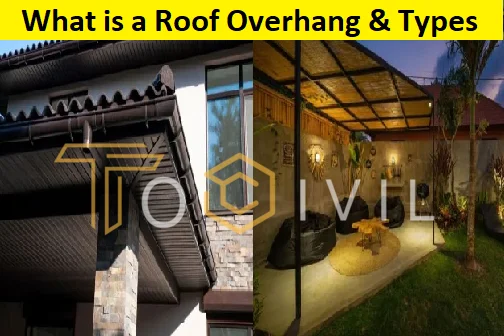What is a Roof Overhang
The Roof Overhang can be described in the following points;
- The amount of overhang on the roof is determined by the distance between the house’s siding and the roof. A soffit is a structure that can be found beneath an overhang.
- The length of an overhang depends significantly on the type of your home and roof.
- Even though slate roofs usually have more extended overhangs than other roofs, almost all buildings have some roof overhang.
- They also vary depending on where you live. Usually, warm or rainy homes tend to have more extended roof eaves than those in colder or drier places.
- Even though slate roofs usually have more extended overhangs than other roofs, almost all buildings have some roof overhang.
- A roof extension is an overhang that goes past the edge of the outside wall of a building. Overwhelming overhangs are often used to keep the sun off a house during the hottest part of the day or summer.
- Overhangs are also used to protect the outside of the house from rain, which would otherwise hit the siding and other outside parts. Even though it doesn’t cover everything, it does an excellent job of minimizing the damage.
- They can rot and fall apart if you don’t protect these structures. Roof overhangs also block some hot sun from shining through windows, stopping glare and keeping extra heat out.
Definition of Roof Overhang
The amount that a roof hangs over a house’s outside wall is called the roof overhang. A roof overhang is also called an eave, and the bottom part is called a soffit.
Roof Overhang
History of Roof Overhangs
Overhangs have been around for a long time. During the Mughal era, from the 16th to the 19th century, they were often used in Indian architecture. Early Buddhist temples also had large overhangs, which later became a part of the architecture of Tibet, China, and Japan.
In European Renaissance architecture, there are also roof overhangs. Overhangs called jetties were on the upper floors of houses made of wood. In the 18th century, when more homes were made of brick and stone, these started to go away.
In colonial America in the 1700s, overhangs were standard in New England. This style has a second story that hangs over the front of the house or goes all the way around it.
At the beginning of the 20th century, architects like Frank Lloyd Wright used the style. He added wide roof overhangs to his modernist style.
Styles of Roof Overhang
There are three styles of roof overhangs:
Open roof Eaves
Most open roof eaves are extended and don’t have a soffit. Their bottoms are open to see the support beams below the overhang.
Closed roof Eaves
When a roof’s eaves are closed, the bottom is covered by soffit material. The soffit covers the underside of the overhang. It hides the rafters when the roof is looked at from below, but they can still be seen when the A-frame of the roof is looked at from the side.
Boxed Eaves
As their name suggests, boxed eaves are entirely closed off with a soffit underneath and fascia boards on the sides, so no rafters are visible. They are literally “boxed-off” from view.
Difference between Styles of Roof Overhangs
Even though open roof eaves may be a little longer than the other choices and therefore move water away from your house more quickly, how they look is a much more important factor. Your roofer can help you decide which style might work best for your roof.
Important Types of Roof overhangs

There are 15 types of roof overhangs. Details are given below;
Overhanging Eaves
The eaves are the overhangs at the end of a roof’s downslope. They are found at the roof’s edge (typically on a pitched top). Because it is on the roof’s lower edge, this type of overhang goes across the roof’s surface.
Hip Overhang
This type of overhang has several slanted edges that come down from all directions. Hip overhangs follow the shape of the roof and usually make the house look better.
Indeed, hip overhangs are the most common overhangs. They withstand wind and rain well and protect homes and buildings against water run-off.
Flat Overhang
Flat overhangs work best on two-story homes because they make it easy to see from windows on the second floor. For this type of roof overhang to work, there needs to be an angle between the wall of the house and the overhang.
Gable Overhang
The gable overhang is shaped like a triangle and sticks out from the eave. It is easy to change to fit the lines of any house. This type of overhang worked well to keep rain and melted snow away because of its steep slopes. Most of the time, the overhang is over front doors or porches.
Awning Overhang
Most homes add this kind of overhang to protect the deck or patio. A home’s awning is not attached to the roof itself so it can be taken down anytime.
People whose windows face south and are exposed to much heat can also use awning overhangs to protect themselves from the heat. When put over a doorway or entrance, they protect people from the weather as they come and go from a house.
Retractable Awning Overhang

Like the above, this type of overhang is put on a house to shade a deck or patio from the sun. Most of the time, they are attached right to the outside wall of a home. This type of awning overhang differs because it has a motorized crank that lets you extend and retract the awning.
If it rains long, the awning can be pulled out to give much protection.
Juliet Awning Overhang
The Juliet awning is not made of any moving parts. It is made of metal, such as copper, aluminum, or steel, and comes in different colors. The top of the awning is straight, and the sides are deep and cupped, with vertical pieces of metal.
This kind of awning overhang can add a nice touch to the front of a house. It can also cover windows to protect people from the sun and weather.
Canopy Overhang

The overhanging canopy is used when there isn’t much room around the door. It has a steep arch and is joined to the outside wall of the house. The best place for the overhang is in the backyard or on a patio.
It has a big frame and posts that hold up a big, strong covering sheet that can be used as a place to sit. Canopy overhangs can be bought in colors and styles that match your home’s decor and architecture.
Screened-in Porch
This structure will keep bugs and other pests away from you. At the same time, it lets cool breezes and fresh air in. The building can be put up in either the front or back yard.
Pergola Overhang
These are often seen in gardens. It is made of beams and rafters that fit together like a grid. The second one is made of beams and has an open top. Pergolas are held up by columns that are either made of wood or stone.
A pergola can also be used as a porch roof, where vines can grow, or clear roof panels can be put up. You can attach this kind of overhang to the outside wall of a house to make a place to sit outside.
Cantilever Roof Overhang
Most modern home designs have this type of overhang. It sticks straight out from the roof as if it were floating.
This kind of overhang looks dramatic and protects well from the weather. Usually, they are flat. The soffit needs more support in places where it snows a lot in the winter.
Bonnet Overhang
The design of the bonnet overhang is adorable. It is made up of two hills. The top slope is steeper and sits higher than the lower slope, which is steeper but not as steep.
There could be problems with this. If the area where the two slopes meet isn’t built and sealed correctly, water may build up there. This kind of roof is also usually more expensive to build.
Curved Overhang
Most of the time, this kind of overhang is found over porches and other entrances to homes. Usually, its base is made of wood, but its coverage is generally made of metals like copper. The second one is heated and bent to follow the shape of the overhang.
You can also change the slope to fit your needs. If you live in an area with much wind, you should choose a lower pitch, so the overhang doesn’t get blown away and broken.
Gambrel Overhang
The gambrel overhang is found on barns, farmhouses, log houses, and some colonial-style homes.
The roof’s peak runs horizontally to the front and back exterior walls and then cascades to a waterfall. This type of overhang has an extreme slope against strong winds and can withstand blowing rain and snow.
Mansard Overhang
This is one of the designs that I like the most. The roof has two slopes on all four sides of a house or building. The slope at the bottom is steeper than the slope at the top. There are dormer windows on the lower pitch. The overhang on all four sides looks like the overhang on a hip roof.
The function of roof overhangs
Here is a list of what roof overhangs are used for.
- An overhang is an essential piece of equipment that should be used to protect property from lousy weather like strong winds and constant rain. The raised edge keeps water from running down the side of the house, but it also picks up snow and other debris as it goes.
- The overhanging roof stops glare and intense heat waves from entering the house through the windows, making it more comfortable to be inside. So, you can just kick back and relax in the comfort of your own home.
- Most of the time, homeowners or contractors change the overhangs based on the weather in the area. Most of Frederick’s homes have overhangs that are the same length.
- Homes where it rains usually have more extended overhangs reaching two feet. This kind of overhang is excellent at keeping most types of rain from doing damage. You will be able to overcome that limitation by installing additional assistance.
Why are Roof Overhangs So Important?
- One of an overhanging roof’s most important jobs is to keep water away from the building’s windows, doors, foundation, and siding.
- Wind-driven rain can’t be stopped, but huge overhangs on the roof can have a significant effect even if there’s only one level below the overhang. Even if an overhang is supposed to protect more than two stories from rain, a building can’t stay dry.
- The good news is that this problem can be fixed by building a “brow roof” above the first floor.
- Walls that get wet often because of small roof overhangs are more of a problem than walls with enough roof overhangs, which makes walls with enough roof overhangs less of a problem. Moisture that stays in one place for a long time can lead to many bad things.
- These problems happen more often in places with an average or above-average amount of rain or snow. But most houses in North America are built in areas where it makes sense to protect walls from wind-driven rain. This is true both along the coast and in the country’s middle.
Gable end Roof Overhang Framing
Gable roof overhangs provide shade and protection from the weather, and some people find them attractive from an aesthetic point of view. The gable roof overhang cuts down on how much rain hits outside the house, protecting it from water damage even more. It also protects doors and entryways, gives shade to windows, and stops too much water from running off the roof and onto the foundation, which helps keep the basement and crawlspace dry. Even though it is an essential part of the house, the roof is also one of the most vulnerable parts when there is much wind.
During a hurricane, tornado, or high winds, the uplift pressures on gable roof overhangs are very high (Figure 1). This means that they can be damaged or blown off, which can damage the roof and other parts of the house’s structure. The exposed top can let rainwater into the building, which can do much damage, like soaking the insulation and ceiling drywall, which could cause the ceilings to cave in and damage the interior finishes and household items.
Method of Gable Roof Overhang Forming
Ladder framing and outrigger framing are two ways to frame gable roof overhangs. When building a new house or fixing up an old one, you can upgrade the gable roof overhang to make sure it meets standards and building codes. You can also decide if going above code for more protection is the right choice for the project.
- Ladder framing
- Outrigger framing
Ladder framing
Ladder framing is made of two long boards that run parallel and are joined by short blocks that look like the rungs on a ladder. The last truss or rafter is nailed through the sheathing on the gable wall and into the previous framing piece. Roof sheathing is put on top of the overhang. It supports the structure and keeps the roof from being lifted by the wind. Most of the time, ladder framing can only be used for 8- to 12-inch overhangs.
Outrigger framing
Most of the time, outrigger framing is used for overhangs over 12 inches. The size of the gable truss, rafter, or truss is changed so that the top level of the end truss or rafter is lower than the top of the rest of the trusses or rafters. This gives the outriggers enough room to go over the end rafter or truss. Outriggers, made of 2x4s or 2x6s, are then put on top of the gable truss or rafter to touch the truss or rafter next to the gable truss and extend outward to support a fascia board along the edge of the overhang. Figures 2 and 3 show this.
More Articles
FAQ’s
How to Build a Gable Roof Overhang
Construct framing at gable roof overhangs resistant to wind uplift forces during hurricanes or other storms. This guide describes two standard gable overhang construction methods, ladder framing and outrigger framing, focusing on applications in coastal high-wind areas.
What is the Formula for roof overhang?
Eaves width divided by cos ° equals overhang (add dimensions for brick veneer).
What is a 4 side roof called?
A mansard roof is a type of gambrel roof with four sides. Each side has a steep slope and a shallow slope on top. Mansard roofs are a popular choice for buildings that want to make the most of their living space because they allow the loft to be used as an extra living space.
How do you extend a roof overhang?
You must provide plenty of underlying support to extend your roof’s overhang. This requires you to extend your rafters. Make your rafter tail extensions three times the length of the final overhang you intend to add. Ensure your lumber is the same size as your home’s existing rafters.
What is the purpose of overhanging eaves?
The overhanging roof stops glare and intense heat waves from entering the house through the windows, making it more comfortable to be inside. So you can kick back and relax in the comfort of your own home.
